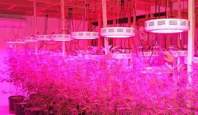Light is the basic environmental factor for plant growth and development. It is not only the basic energy source for photosynthesis, but also an important regulator of plant growth and development. The growth and development of plants is not only restricted by the amount or intensity of the 800wLED plant light, but also by the light quality, that is, different wavelengths of light and radiation and their different component ratios.
Plants can perceive subtle changes in the quality, intensity, length and direction of the 800w LED plant light in the growing environment, and trigger the physiological and morphological changes necessary for survival in the environment. Blue light, red light and far-red light play a key role in controlling the light form of plants. Photoreceptors, cryptochromes, and luminosin receive light signals and initiate changes in plant growth and development through signal transduction.
800w LED plant light white light
The dry weight of tomato seedlings grown under white light (including red, blue, and green light) was significantly lower than that of tomato seedlings grown under red and blue light. The results of tissue culture growth inhibition spectroscopy showed that the most harmful light quality is green light with a peak at 550 nm. The height, freshness and dry weight of marigold plants grown under light that removes green light are 30% to 50% higher than those grown under full-spectrum light. The full-spectrum light supplements the green light, so that the plants are short and dry, and the fresh weight is reduced. Removing green light will promote the blooming of marigolds, while adding green light will inhibit the blooming of dianthus and lettuce.
800wLED plant light yellow light
Yellow light (580~600nm) inhibits the growth of lettuce. The chlorophyll content and dry weight are used to draw different proportions of red light, far red light, blue light, ultraviolet light and yellow light. The results show that only yellow light (580-600nm) can explain the difference in the growth effect of high-pressure sodium lamps and metal halide lamps. That yellow light will inhibit growth. In addition, yellow light (peak at 595nm) inhibits cucumber growth more strongly than green light (peak at 520nm).
Some conflicting conclusions about the yellow/green light effect may be due to the inconsistent wavelength ranges used in these studies. In addition, because some researchers classify light from 500 to 600 nm as green light, there is little literature on the effect of yellow light (580 to 600 nm) on plant growth and development. Ultraviolet radiation reduces plant leaf area, inhibits hypocotyl elongation, reduces photosynthesis and productivity, and makes plants vulnerable to pathogens, but can induce flavonoid synthesis and defense mechanisms. UV-B can reduce the content of ascorbic acid and β-carotene, but can effectively promote the synthesis of anthocyanins. UV-B radiation causes changes in the phenotype of dwarf plants, with small and thick leaves, short petioles, and increased axillary shoots and root/shoot ratios.
800wLED plant light far red light
In many cases, the red light effect can be offset. Low R/FR ratio leads to reduced photosynthetic capacity of kidney beans. The growth room uses white fluorescent lamps as the main light source, and 800w LED plant lamps are used to supplement far-red light radiation, which reduces the content of anthocyanins, carotenoids and chlorophyll, and increases the fresh weight, dry weight, stem length, leaf length and leaf width of the plant. The growth-promoting effect of FR supplementation may be due to increased leaf area leading to increased light absorption. Compared with Arabidopsis thaliana grown under high R/FR conditions, Arabidopsis thaliana grown under low R/FR conditions has larger and thicker leaves, greater biomass, and stronger cold tolerance. Different R/FR ratios will also change the salt tolerance of plants.
800wLED plant light blue
High plant chlorophyll synthesis and chloroplast formation, as well as high chlorophyll a/b ratio and low carotenoid levels, all chloroplasts need blue light. Under red light, the photosynthetic rate of umbrella cells gradually decreases, and after switching to blue light or adding some blue light under continuous red light, the photosynthetic rate quickly recovers. When dark-growing tobacco cells are transferred to continuous blue light for 3 days, ribulose bisphosphate carboxylase/oxygenase (rubulose-1, 5-bisphosphate
Obviously, red light is not enough for the photosynthesis and growth of plants. Wheat can complete its life cycle under a single red LED light source, but in order to obtain tall plants and a large number of seeds, it is necessary to add an appropriate amount of blue light (Table 1). The yield of lettuce, spinach, and radish under single red light is lower than that under the combination of red and blue light, while the yield under the combination of red and blue light is low under a moderate amount of red light. Blue light is comparable to plants growing under cool white fluorescent lights. Similarly, Arabidopsis thaliana can produce seeds under a single red light, but compared with plants grown under a cool white fluorescent lamp, as the proportion of blue light decreases (10% to 1%), red and blue light The bolting, flowering and fruiting of the growing plants are delayed. However, the seed yield of plants grown under a red-blue combination of 10% blue light is only half that of plants grown under cool white fluorescent lights. Excessive blue light inhibits plant growth, the internodes become shorter, the branches decrease, the leaf area becomes smaller, and the total dry weight decreases. There are obvious species differences in the blue light demand of plants. And the total dry weight is reduced. There are obvious species differences in the blue light demand of plants. And the total dry weight is reduced. There are obvious species differences in the blue light demand of plants.
800wLED plant light green light
But the conclusion that supplementing green light promotes growth and produces more biomass is more problematic than cold white light: (1) The dry weight of biomass they observed is only the dry weight of the above-ground part. If the dry weight of the underground root system is included, the results may be different; (2) Lettuce grown under red, blue, and green lights grows larger than the cold white fluorescent lights. The plants are likely to be the green light of these three-color lights ( 24%) is much smaller than that of cool white fluorescent lamps. Cool white fluorescent lamps (51%) means that the green light suppression effect of cool white fluorescent lamps is greater than that of tri-color lamps. Light effect; (3) The photosynthetic rate of plants grown under the combination of red and blue light is significantly higher than that of plants grown under green light, which supports the previous speculation. Blue and green light plants grow larger than cool white fluorescent lamps. It is probably because the green light (24%) of these tri-color lamps is much lower than that of cool white fluorescent lamps (51%), that is, the green light suppression effect of cool white fluorescent lamps Larger than three-color lights. Light effect; (3) The photosynthetic rate of plants grown under the combination of red and blue light is significantly higher than that of plants grown under green light, which supports the previous speculation. Blue and green light plants grow larger than cool white fluorescent lamps. It is probably because the green light (24%) of these tri-color lamps is much lower than that of cool white fluorescent lamps (51%), that is, the green light suppression effect of cool white fluorescent lamps Larger than three-color lights. Light effect; (3) The photosynthetic rate of plants grown under the combination of red and blue light is significantly higher than that of plants grown under green light, which supports the previous speculation.
The green light effect is usually the opposite of the red and blue light effects. Green light can reverse the stomata opening promoted by blue light. However, treating the seeds with a green laser can make radishes and carrots double the control. The dim green light pulse can accelerate the growth of seedlings growing in the dark, that is, promote the elongation of the stem. Treatment of Arabidopsis albino seedlings with a single green light (525 nm ± 16 nm) pulse (11.1 μmol·m-2·s-1, 9s) from an LED light source resulted in decreased plastid transcription and increased stem growth rate.
The effect of LED plant light quality on the photosynthetic characteristics of plants, LED plant growth light has a regulatory effect on the synthesis of chlorophyll, different light has different effects on plants, if you don’t know which light quality to choose for supplement light, you can Choose and customize according to the light quality requirements of plants.






